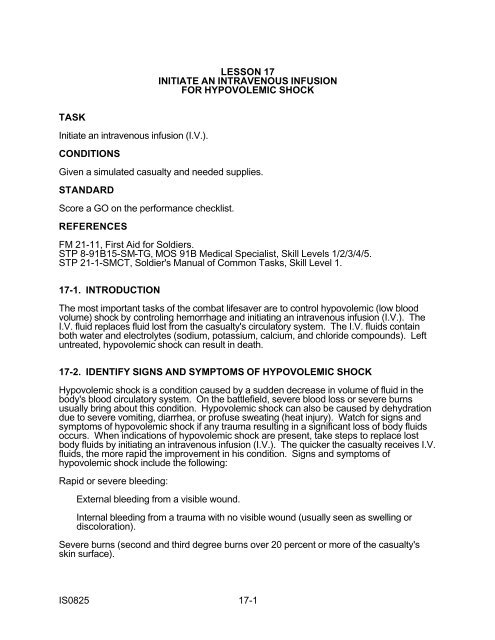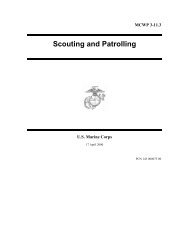US-Army-IS-0825-medical-course-Combat-Lifesaver-Course-0825CC1
US-Army-IS-0825-medical-course-Combat-Lifesaver-Course-0825CC1
US-Army-IS-0825-medical-course-Combat-Lifesaver-Course-0825CC1
Create successful ePaper yourself
Turn your PDF publications into a flip-book with our unique Google optimized e-Paper software.
LESSON 17<br />
INITIATE AN INTRAVENO<strong>US</strong> INF<strong>US</strong>ION<br />
FOR HYPOVOLEMIC SHOCK<br />
TASK<br />
Initiate an intravenous infusion (I.V.).<br />
CONDITIONS<br />
Given a simulated casualty and needed supplies.<br />
STANDARD<br />
Score a GO on the performance checklist.<br />
REFERENCES<br />
FM 21-11, First Aid for Soldiers.<br />
STP 8-91B15-SM-TG, MOS 91B Medical Specialist, Skill Levels 1/2/3/4/5.<br />
STP 21-1-SMCT, Soldier's Manual of Common Tasks, Skill Level 1.<br />
17-1. INTRODUCTION<br />
The most important tasks of the combat lifesaver are to control hypovolemic (low blood<br />
volume) shock by controling hemorrhage and initiating an intravenous infusion (I.V.). The<br />
I.V. fluid replaces fluid lost from the casualty's circulatory system. The I.V. fluids contain<br />
both water and electrolytes (sodium, potassium, calcium, and chloride compounds). Left<br />
untreated, hypovolemic shock can result in death.<br />
17-2. IDENTIFY SIGNS AND SYMPTOMS OF HYPOVOLEMIC SHOCK<br />
Hypovolemic shock is a condition caused by a sudden decrease in volume of fluid in the<br />
body's blood circulatory system. On the battlefield, severe blood loss or severe burns<br />
usually bring about this condition. Hypovolemic shock can also be caused by dehydration<br />
due to severe vomiting, diarrhea, or profuse sweating (heat injury). Watch for signs and<br />
symptoms of hypovolemic shock if any trauma resulting in a significant loss of body fluids<br />
occurs. When indications of hypovolemic shock are present, take steps to replace lost<br />
body fluids by initiating an intravenous infusion (I.V.). The quicker the casualty receives I.V.<br />
fluids, the more rapid the improvement in his condition. Signs and symptoms of<br />
hypovolemic shock include the following:<br />
Rapid or severe bleeding:<br />
External bleeding from a visible wound.<br />
Internal bleeding from a trauma with no visible wound (usually seen as swelling or<br />
discoloration).<br />
Severe burns (second and third degree burns over 20 percent or more of the casualty's<br />
skin surface).<br />
<strong>IS</strong><strong>0825</strong> 17-1



